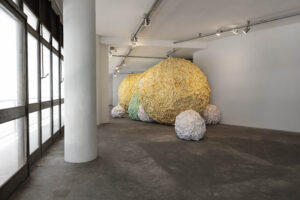Caroline Mesquita (born in Brittany, France) has been developing a
multimedia practice, mixing large-scale sculptures and installations with
video and sound, since finishing her studies at the École Nationale de
Beaux-Arts in Paris. Pool tables, motorcycles, engines and drums form her
first sculptures, which she manufactured herself by roughly handling heavy
metals and ornamenting surfaces with different patterns and shades of
oxidation. In 2015, she began to roll brass plates into playful spirals that mimic
life-size human figures. The rolled metal resembles the elegant skirt of a lady,
a hat or an arm angrily raised. After 123 Soleil (2015) a large arrangement
with almost twelve figures was presented at an art fair in Berlin, her gallery
decided to store the figures in smaller groups. Mesquita was intrigued by the
narratives that emanated from the intimate groups of two or three characters,
in comparison with the monumentality of the whole group.
This was when she had the idea to animate her sculptures through film by
using stop-motion, a technique both simple and powerfully expressive. In
one of her first videos, Pink Everywhere (2016) she is the protagonist; the
creator “possessed” by her creation. Later, she incorporated other actors,
who often played several characters at once, suggesting “the versatility
of identity and fate”, she explains. The fictional backgrounds are always
conjured by mysterious catastrophes that send their human protagonists
to sleep or die: an enchanted house (The Visitors, 2017), a machine room
on fire (The Machine Room, 2018), and a plane crash (The Ballad, 2017).
The sculptures eagerly seek interaction with the characters’ unconscious
flesh, healing wounds or inversely causing stains of red paint that mark their
silent juvenile faces. The pleasure of cheap special effects that achieve the
maximum level of spectacle. Suddenly, the stories become pretexts for
building ever more complex sculptural environments or, in fact, precisely
the contrary: the growing pleasure of building ever more complex “objects”
inspires Mesquita to create increasingly surrealist tales. The stop-motion
gives the films a Melièsque touch, but they are also inspired by 1970s’ Polish
avant-garde cartoons, among other sources of inspiration.
In order to test the scale and overall structure of her installations, Mesquita
began to make life-size paper and cardboard models in her studio. At the
same time, building her spiral characters led her to further investigate the
real structure of the human body, in particular the bones. These reflections
culminated in Astray (2018-19), a two-year-long project that narrates the
rebirth of forgotten bones discovered in the gallery, which are brought to
life through the simple gesture of being watered. Here, human performers
are awake and alive; their interactions with a series of cardboard animals are
playful and vigorous.
With In Vivo, the video installation presented at Pivô in her first exhibition
in Brazil, Mesquita expands on the manipulation of cardboard and paper,
materials which differ from metal for their rougher aspect and the way they
leave more room for the fragile and the ephemeral. In this oneiric exploration
of the inside of the body, once again micro-dramas flirt with the burlesque,
as human body parts and DIY worlds dissolve into one another. Humans
are no longer lifeless, nor do they simply coexist with the sculptures. Instead
as suggested by the first scene where a surgeon’s hands, painted in white,
dive greedily in the entrails of the butchered patient who lends their belly to
the artist’s experiment humans are finally ready to merge with the sculptural.
Throughout the film, body parts play peek-a-boo with reconstructed cells,
viruses, platelets and gametes, confusing our perception of scale, texture and
function. Snuggled inside the cell-like structures and nestled in the Copan
building like bacteria in the guts of a giant body, viewers are immersed in
the loud sound that replicates what happens in the silence of their own
organisms. Here, Caroline Mesquita’s intention is to make us aware of the
details, geometries, sounds, and pulsations that irrigate the living. During
the production phase, she was marvelled at the idea that she was “sculpting
herself inside out”. Thinking of art as a way to sensitively connect with our
environment, In Vivo proposes a kind of meditation on our human condition,
affirming the need to understand the world through the mutual organic
processes that make up our shared realities.

Pivô, São Paulo
Caroline Mesquita | In Vivo
22.10.–19.12.2020

